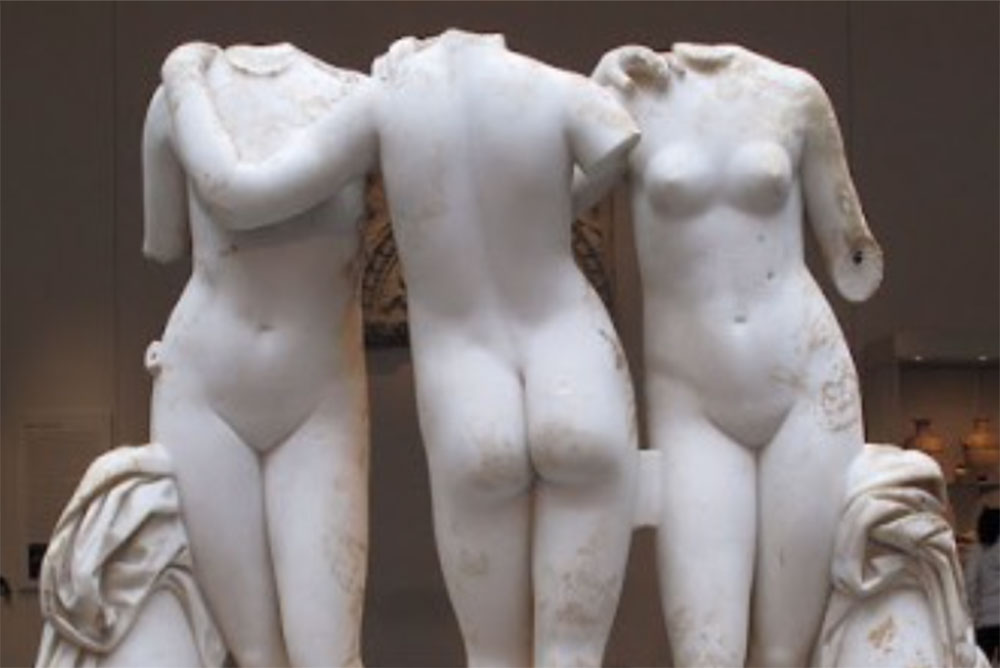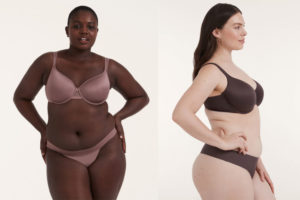
This marble statue group of the Three Graces dates back to the 2nd century AD and is a Roman copy of a Greek work from the 2nd century BC. It’s in the collection of the Metropolitan Museum of Art.
A version of this article appeared first on Prime Women.
THE NEXT TIME you’re at the bathroom mirror and you pull back the skin along your jawline so you can actually see your former jawline, or the next time you take a hasty dressing-room selfie so you can see how bad those pants look Back There, ask yourself this: If I were a man would I be doing this?
I”m not a man so I can’t be 100 percent sure about this, but I’m willing to bet that most members of the other sex (to be binary for a moment) don’t spend all that much time beating themselves up over the way they look. Take me as I am, I imagine them thinking as they run their fingers through hair still wet from the shower. Gray at the temples? Distinguished. Crinkles around the eyes? Craggy and lived-in. We know this. None of this is news. And yet.
It’s been 41, count ’em 41, years since publication of Fat Is a Feminist Issue, the 1978 blockbuster by British psychotherapist Susie Orbach. The deference shown, Orbach argued, by women and girls to judgment by the culture at large, vis-à-vis fat and other factors, has severely curtailed their—our—autonomy and encouraged us to live under constant threat of rejection. All of which has led to an unhealthy relationship with food, whether over-dieting or overeating, and a vast ongoing dissatisfaction with our own bodies. Forty-one years. Yet here we are, still.
 There’s a delicious bit in one of the early episodes of The Marvelous Mrs. Maisel, the Amazon web series set in the 1950s. In it we learn that Mrs. Maisel’s mom is in the habit of sneaking out of bed before dawn to put on fresh makeup—just so her husband can express awe at how sparkly and fresh she looks even in the morning.
There’s a delicious bit in one of the early episodes of The Marvelous Mrs. Maisel, the Amazon web series set in the 1950s. In it we learn that Mrs. Maisel’s mom is in the habit of sneaking out of bed before dawn to put on fresh makeup—just so her husband can express awe at how sparkly and fresh she looks even in the morning.
Did that really happen in the ’50s? Probably not, yet there’s no doubt a kernel of truth to it. (How many of us watched and thought, Wow, I should have thought of that!?)
Anyway, the message seems to be that while men are still rubbing the sleep out of their eyes, here we are, the other half of humanity, pinned to the board like some butterfly specimen, just waiting . . . to be looked at? admired? judged?
It’s a common complaint that advertising and “the media” at large have exacerbated the situation, using images of impossibly unblemished exemplars of female beauty to flog everything from toilet paper to $5,000 handbags. And they are certainly guilty as charged, leading a lot of us to wish we could Photoshop ourselves in real life.
But even female celebs noted for their brains as well as their beauty aren’t quite good enough sometimes. There was a before-and-after example in 2006 of a promotional photo shoot featuring TV’s cute little Katie Couric. But not little enough, apparently. The original image showed how the final picture had nipped in Couric’s waist, jussssst a little bit.
I spied another example a couple of years ago, one that I found touching at the same time it was arguably disrespectful. It was a YouTube video of the singer Adele backstage greeting admirers. Adele has famously announced that she would never be one of those Twiggy girls, yet here she was, looking more svelte than she had in her earlier days. But it seemed not good enough for the fan whose camera we were viewing her through. After he centered the singer in his lens, he adjusted something that elongated the image upward, making Adele ever so slightly taller and slimmer, more Modigliani than Botero.
I like to think the fan-photographer adjusted the picture out of admiration for Adele: In my mind, he wanted her to look as close to “ideal” as possible. Nonetheless, in this one private act, it was the real Adele who was declared less than acceptable.
 Is there any progress at all in body acceptance? Well, Unilever’s Dove soap has been championing Real Beauty with ads that use women with various (to a certain extent) body shapes since 2004. Dove re-upped its commitment in 2017, pledging to use no models and no digital distortion or manipulation of images. The brand now featuring “civilians” of different sizes, races and, perhaps the ultimate no-no, ages. Apparently women with gray or white hair are also allowed to wash with Dove.
Is there any progress at all in body acceptance? Well, Unilever’s Dove soap has been championing Real Beauty with ads that use women with various (to a certain extent) body shapes since 2004. Dove re-upped its commitment in 2017, pledging to use no models and no digital distortion or manipulation of images. The brand now featuring “civilians” of different sizes, races and, perhaps the ultimate no-no, ages. Apparently women with gray or white hair are also allowed to wash with Dove.
Last fall, the five-year-old buzzy online maker of ThirdLove bras commandeered an entire page of the New York Times to rip Victoria’s Secret’s whole focus as playing to the male gaze. In February the lingerie newcomer upped the ante by increasing its offerings to 78 bra sizes and showing pictures of 78 women in their undies. This was the ad where the rubber met the road, as the old slogan goes. Here were billowing breasts and bellies hanging over the waistband of bikini panties; some arms were as plump as dachshunds, others showed bony elbows. One woman had a prosthetic arm. Real women, and presumably one brave veteran, in other words.
As ThirdLove co-founder Heidi Zak told the CEO of Victoria’s Secret in the Times ad, “It’s time to stop telling women what makes them sexy—let us decide.”
But there’s a problem with that. Only last week the Prime Women website spotted and re-posted a Facebook photo of a shapely woman standing in the surf, grinning with delight in her black bikini. Lovely-looking woman, healthy and fit.
So what was the reaction from Prime Women readers? There were admirers, of course, who celebrated the spirit of the woman in the photo. But some other posters were vicious and came at the image from all sides.
Suggesting that the woman’s figure wasn’t quite up to par, one poster snapped that the picture had been Photoshopped and the woman was “definitely holding her gut in.” (Gee, in that setting so would I!) Another decried running a bikini picture at all, thereby perpetuating the myth of ideal beauty. Another wanted instead to see women who were “using the last decades of their life to make a difference.” (For all we know, that woman is the head of a nonprofit fighting domestic abuse. She also likes to go to the beach.)
The vehemence of the reactions shouldn’t be a surprise: If fat was, and is, a feminist issue, so are fitness, beauty and all the messages we suspect are lurking behind a simple holiday snapshot. It took a long, long time for our culture to put us in this position—the Three Graces sculpture from 2nd-century-BC Greece comes to mind. It’s going to take a lot more than Dove soap to clean it all up.
—Nancy McKeon
MyLittleBird often includes links to products we write about. Our editorial choices are made independently; nonetheless, a purchase made through such a link can sometimes result in MyLittleBird receiving a commission on the sale, whether through a retailer, an online store or Amazon.com.


This column could generate a long-term, on-going discussion. Since my husband has rarely, if ever, spontaneously commented on my appearance, I long ago dedicated my looks to myself. I am the one I dress for, stay in shape for, take care of my face for. Yes, I am clearly showing the effects of age, but I vowed as a teenager watching my mother and her friends getting heavier and heavier, that I was going to go down fighting. And if I say so myself, I still look pretty damn good, and feel pretty damn good. We are our own masters, of all.
I’m with you, Nance.
It absolutely happened. 1971 or so, even, a friend related that her mother got up early every day to apply full makeup and then went back to bed to “wake up” with her husband.
Oh man! I thought moving to the Upper East Side would make me “put on my face” every day. Hasn’t happened yet. I can’t even imagine interrupting my sleep to do it!
Wow. Thank you. This is long overdue. Just posted it to my Facebook groups, including one devoted to divorced women. So many of them in the throes of self hatred because of men that left them for someone younger…fresher.
Call it narcissism, call it Peter Pan Syndrome…just so happy you called it out!
Parts of the situation remind me of Walt Kelly’s Pogo saying, “We have met the enemy and he is us.”